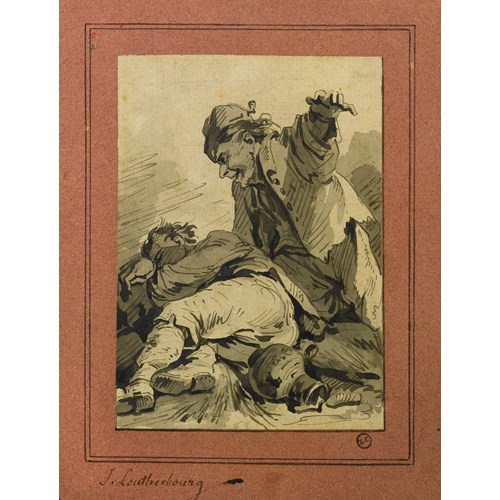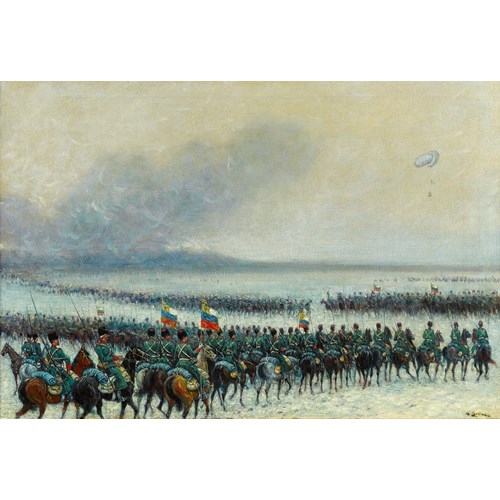Marketplace
A Russian Cavalry Officer (recto) and Other Sketches of Various Characters (verso)
Ivan Alekseevich Vladimirov
A Russian Cavalry Officer (recto) and Other Sketches of Various Characters (verso)
Period 20th century
Origin Russia
Medium Pen, Ink on paper
Dimension 28.5 x 38.8 cm (11¹/₄ x 15¹/₄ inches)
These two drawings encapsulate the curiously two-sided and diverse nature of Ivan Alekseevich Vladimirov’s career. In the centre of the recto, a cavalry officer sits stiffly astride a lean, muscular horse. This is the most polished depiction on either side of the work and bears the artist’s signature. Vladimirov uses an ink wash, rather than hatching, to model both horse and rider, which accounts for the animal’s sleek appearance. Wash is also used in order to create a faint background in which to contextualise the two. Surrounding this central depiction are a variety of figures demonstrating a range of type and technique. Some, such as the suited man in the upper-left hand corner of the sheet, are quite detailed and the heavy cross-hatching reveals the attention Vladimirov took over this figure. In contrast other figures are comprised of only a few lines. The social types range from important army officers to waiters, and their treatment from skilful portraiture to caricature in the lower left, with an officer’s absurdly oversized moustache. Although there is no such caricature on the verso, a central drawing of a mounted soldier is once more surrounded by other figures. Many of these appear to be Russian peasants and it is noteworthy that many of them are very distinctive, with thick beards or other prominent facial features. Despite being quick sketches, these drawings are imbued with a remarkable amount of character. His study of the Russian cavalry also continues on the left-hand side of the verso where two horses trot into the distance.
Hubertus Jahn writes that Vladimirov’s favourite subject was ‘Cossacks on horseback somewhere in the great outdoors’, and, although the figures are military, the repeated prominence of the equestrian figures in the present work reflects Jahn’s assertion.¹ The Campaign (Private Collection), shows studies of the type in the present drawing, worked up into a more finished piece. The importance that Vladimirov placed on the individualisation of figures is again reflected in The Campaign, and the skilful use of wash that is evident in the cavalry officer on the present recto, occurs on a larger scale here.
Vladimirov is perhaps best known for his Socialist Realist masterpieces which extolled the heroics of the Soviet Union. He produced many official propaganda works and depicted scenes of Soviet leaders such as Joseph Stalin (1878-1955) and Vladimir Lenin (1870-1924). Although he was very much part of the art establishment, and glorified the political regime in many of his works, it seems that he did not share the ideology which, by necessity, he promoted. For years he secretly produced works under the pseudonym ‘John Wladimiroff’, which were smuggled to the West and served to highlight Bolshevik atrocities. These paintings show the cruelties committed towards peasants and supporters of the Imperial family. The humanity evident in these pictures is reminiscent of the sympathetic, almost heroic, portrayals of peasants in the present work. It is also noticeable that the more ridiculous figures in A Russian Cavalry Officer and Other Sketches of Various Characters are those who appear to be in positions of authority.
Vladimirov was born in Lithuania to a Russian father and British mother. He spent much of his youth abroad and spent time in the army before training as an artist. During the First World War, he recorded the Eastern Front for The Graphic, a London based weekly pictorial journal. He continued to document the Russian revolution and spent the latter part of his life, a respected establishment figure, secretly undermining it. The present sheet of drawings highlights the variety of themes and figures that, as a result of his secret views, occurred throughout his work.
¹ Jahn, H. J., Patriotic Culture in Russia during World War I (Cornell University Press, New York, 1998), p.35.
Hubertus Jahn writes that Vladimirov’s favourite subject was ‘Cossacks on horseback somewhere in the great outdoors’, and, although the figures are military, the repeated prominence of the equestrian figures in the present work reflects Jahn’s assertion.¹ The Campaign (Private Collection), shows studies of the type in the present drawing, worked up into a more finished piece. The importance that Vladimirov placed on the individualisation of figures is again reflected in The Campaign, and the skilful use of wash that is evident in the cavalry officer on the present recto, occurs on a larger scale here.
Vladimirov is perhaps best known for his Socialist Realist masterpieces which extolled the heroics of the Soviet Union. He produced many official propaganda works and depicted scenes of Soviet leaders such as Joseph Stalin (1878-1955) and Vladimir Lenin (1870-1924). Although he was very much part of the art establishment, and glorified the political regime in many of his works, it seems that he did not share the ideology which, by necessity, he promoted. For years he secretly produced works under the pseudonym ‘John Wladimiroff’, which were smuggled to the West and served to highlight Bolshevik atrocities. These paintings show the cruelties committed towards peasants and supporters of the Imperial family. The humanity evident in these pictures is reminiscent of the sympathetic, almost heroic, portrayals of peasants in the present work. It is also noticeable that the more ridiculous figures in A Russian Cavalry Officer and Other Sketches of Various Characters are those who appear to be in positions of authority.
Vladimirov was born in Lithuania to a Russian father and British mother. He spent much of his youth abroad and spent time in the army before training as an artist. During the First World War, he recorded the Eastern Front for The Graphic, a London based weekly pictorial journal. He continued to document the Russian revolution and spent the latter part of his life, a respected establishment figure, secretly undermining it. The present sheet of drawings highlights the variety of themes and figures that, as a result of his secret views, occurred throughout his work.
¹ Jahn, H. J., Patriotic Culture in Russia during World War I (Cornell University Press, New York, 1998), p.35.
Period: 20th century
Origin: Russia
Medium: Pen, Ink on paper
Signature: Signed in Cyrillic (lower right).
Dimension: 28.5 x 38.8 cm (11¹/₄ x 15¹/₄ inches)
More artworks from the Gallery


 and Other Sketches of Various Characters (verso)_T637904672381408978.jpg?width=2000&height=2000&mode=max&scale=both&qlt=90)






